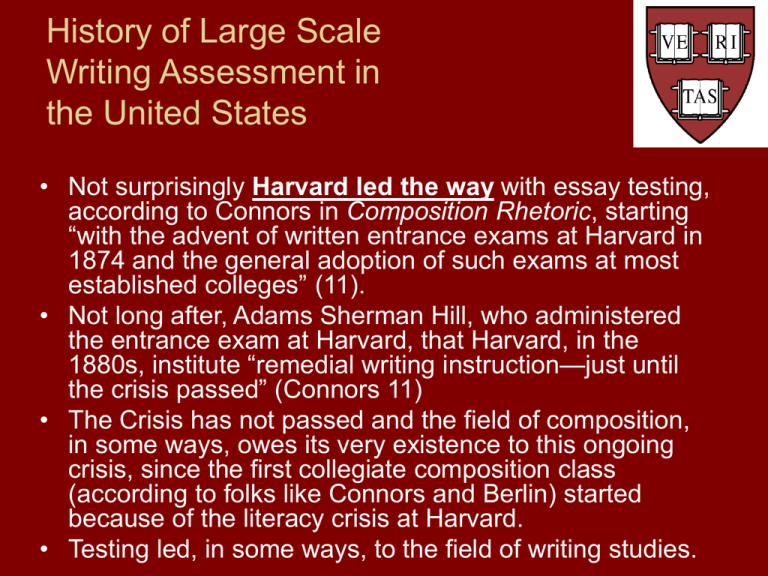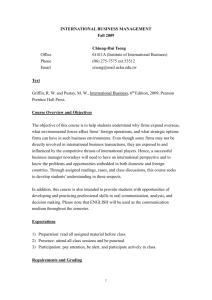document
advertisement

History of Large Scale Writing Assessment in the United States • Not surprisingly Harvard led the way with essay testing, according to Connors in Composition Rhetoric, starting “with the advent of written entrance exams at Harvard in 1874 and the general adoption of such exams at most established colleges” (11). • Not long after, Adams Sherman Hill, who administered the entrance exam at Harvard, that Harvard, in the 1880s, institute “remedial writing instruction—just until the crisis passed” (Connors 11) • The Crisis has not passed and the field of composition, in some ways, owes its very existence to this ongoing crisis, since the first collegiate composition class (according to folks like Connors and Berlin) started because of the literacy crisis at Harvard. • Testing led, in some ways, to the field of writing studies. An Interesting Beginning • Around the same time that writing exams are beginning, we have Alfred Binet (1859-1911), creating the first “intelligence test” in 1905, which was administered to Paris school children would “do tasks such as follow commands, copy patterns, name objects, and put things in order or arrange them properly” (PBS) • Here we have the beginning of psychometrics, with IQs, and numbers seeming to represent a “native intelligence.” • There must have been something in the water at the turn of the 20th century. Early Tests • It would be fair to say that they were based on an idealized curriculum. • And it would be fair to say that this was about sorting students from the very beginning, which is the point that Robert Connors, Richard Ohman, James Berlin, and many others make. • It would also be fair to say that early tests were punitive in nature—sort out those who needed “remediation”. (Note the latinate word, the semimedical terminology.) Classroom Assessment and Testing: What We Do, But Loathe • One of my favorite pieces on grading and classroom assessment goes by the great title: “Why I (Used to) Hate to Give Grades” by Lynn Z. Bloom, which is less hopeful than it sounds. • Bloom has “made peace” with grading. However, that doesn’t mean she likes it. • Generally grading is not loved, by teachers or students, but I’m not telling you anything you don’t know. Classroom Assessment and Testing: What We Do, But Loathe • But does it have to be this way? • Responses: – – – – __________________________ __________________________ __________________________ __________________________ • Ultimately, this class will deal with this as an affective and practical issue—but also as a potential area of very interesting research. What We Know About Grading and Responding to Student Papers • From John Bean, we know that there are ways to cut back on the teaching load: responding to drafts and quickly grading. Also, rubrics—which Heidi Andrade writes about with great gusto. • We know, from an array of folks (Haswell, Sommers and Lees) that teachers tend to mark too much and focus too much on grammar. • From Tom Newkirk, we know this: oftentimes our comments are misinterpreted by students, and we often misinterpret student writing. More on Large Scale Tests • Historically, we have the formation of CCCC in 1950, and from the beginning, writing assessment “surely was there” (Yancey 483). • As Yancey Describes it, assessment has moved in three waves that have never entirely subsumed previous waves: – Objective Tests: 1950-70 – Holistically scored tests: 19701986 – Portfolios: 1986 to present • Through it all writing assessment is a place of contest, politics, and considerable disagreement. Primary and Secondary Writing Tests and Assessments • Past: Objective tests—remember Binet and the IQ tests. • Then: Written tests – New York Regents tests • Now: – SAT 2 – NCLB – Accountability: Everything from the Spelling’s Commission, to NCLB, to state legislatures. – FCAs and John Collins: Reductive and, maybe, effective. – Hopefully: Directed Self-Placement, like what Royer and Gilles describe at Grand Valley State in Michigan. Wither Writing Assessment? Whither Us? • There are computers, like erater, that promise online writing assessment. • There are things like TOPIC and IMOAT, that help place, and then grade, student work—but rely on humans to respond to writing. • Then there’s us, figuring out what we will write and research about: – – – – – – Large Scale Writing Assessments, Classroom Assessment Practices, Campus-wide Assessments, Portfolio Assessments, Computerized Writing Assessment, And other things? Works Cited • • • • • • • • • Andrade, Heidi. “Using Rubrics to Promote Thinking and Learning.” Educational Leadership. 57.5. February 2000, 13-18. 4 January 2008. http://www.ascd.org. Bean, John. Engaging Ideas: The Professor's Guide to Integrating Writing, Critical Thinking, and Active Learning in the Classroom. New York: JosseyBass, 1996. Connors, Robert. Composition-Rhetoric: Backgrounds, Theory and Pedagogy. Pittsburgh, PA: UP of Pittsburgh, 1997. Haswell, Richard H. "Minimal Marking." College English 45.6 (Oct. 1983): 600-604. Lees, Elaine O. "Evaluating Student Writing." College Composition and Communication 30.4 (Dec. 1979): 370-374. Newkirk, Thomas.(1984). How students read student papers: An exploratory study. Written Communication, 1(3), 283-305. PBS. “Binet Pioneers Intelligence Testing.” 1998. http://www.pbs.org/wgbh/aso/databank/entries/dh05te.html. 4 January 2008. Sommers, Nancy. "Responding to Student Writing." College Composition and Communication 33.2 (May 1982): 148-156. Yancey, Kathleen Blake. “Looking Back as We Look Forward: Historicizing Writing Assessment as a Rhetorical Act.” 50.3. February 1999, 483-503.



